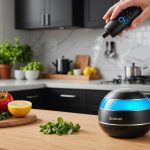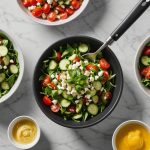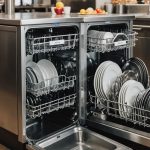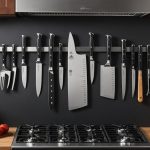Understanding UV Light Sanitizers
The world of UV light sanitizers is fascinating and beneficial, particularly in enhancing kitchen hygiene and food safety. This technology operates using ultraviolet (UV) light to disrupt the DNA of microorganisms. When UV light comes in contact with pathogens, it damages their genetic material, rendering them unable to reproduce, thus neutralizing potential threats.
One of the key benefits of UV light sanitizers is their ability to enhance food safety by reducing the risk of contamination effectively. Unlike traditional cleaning methods, UV sanitizers can reach crevices and surfaces that are often missed. This quality is crucial in environments like kitchens, where hygiene standards must be rigorously maintained.
Also to discover : Energize your calorie burning: revolutionize your cooking space with a bluetooth speaker for dancing and musical enjoyment!
The scientific principles that underscore UV light’s potency in sanitization hinge on the specific wavelengths it employs—primarily UV-C light. These wavelengths are particularly effective in neutralizing a broad spectrum of microorganisms, including bacteria, viruses, and fungi. By breaking down the DNA of these microbes, UV light prevents them from proliferating.
Incorporating UV light sanitizers into one’s hygiene routine offers a non-chemical means of achieving superior sanitation, empowering individuals to uphold a safer and cleaner kitchen environment.
Have you seen this : Revitalize your kitchen with uplifting quotes: a fresh strategy for encouraging healthier eating choices
Impact on Nutritional Value
Understanding how UV light sanitization impacts nutritional preservation and food quality is crucial. Unlike conventional methods, which may lead to loss of nutrients, UV treatment tends to be more gentle.
Sanitizing food with UV light can effectively maintain the nutritional preservation and food quality by targeting microorganisms without using heat or chemicals. This approach helps retain vital nutrients such as vitamins and antioxidants. In contrast, traditional methods like high-temperature treatment can degrade these essential nutrients.
Studies have demonstrated the benefits of UV treatment. For instance, research indicates that UV light can preserve vitamin C in fruits, unlike some conventional techniques which can result in a significant reduction. This method also maintains the texture and flavor of foods, contributing further to quality.
In comparison with older methods, UV treatment offers a balance of sanitation and nutritional preservation. It maintains the integrity of food while ensuring it is safe to consume. Such findings highlight the advantages of adopting UV treatment as part of modern food safety practices. Thus, both the nutritional retention and improvement in food quality make UV treatments a compelling alternative to traditional sanitation methods.
Product Reviews and Comparisons
We delve into the latest UV light sanitizer reviews and the way they compare to other kitchen products. This section aims to help consumers make informed comparisons when investing in new kitchen appliances.
Top UV Light Sanitizers on the Market
In the world of kitchen products, not all UV light sanitizers are alike. Popular models frequently highlighted include Brand A and Brand B, known for their robust sanitation capabilities. Users appreciate ease of use and longevity in these models, which often set them apart in the consumer comparisons landscape.
Key Features to Consider
When selecting a UV light sanitizer, consider features like the duration of the sanitizing cycle, portability, and energy efficiency. A powerful LED display and intuitive controls often enhance usability. Additionally, the effectiveness against a broad spectrum of pathogens is critical for assessing a product’s quality.
Price vs. Performance Analysis
Achieving the perfect balance between price and performance in kitchen appliances can often be elusive. Typically, models in the mid-range price bracket, like Brand C, offer the best value for money. They integrate vital features without the hefty price tag, easing concerns in the consumer comparisons process. Understanding user feedback often sheds light on real-world efficiency, guiding readers in making confident purchasing decisions.
Practical Guide for Kitchen Integration
Integrating UV light usage into your kitchen routine can significantly enhance sanitation practices. Here’s how you can seamlessly incorporate this technology.
Start by selecting a UV light sanitizer suitable for your kitchen size. Placement is crucial—install UV lights in areas frequently exposed to germs, like cutting boards or countertops. Regularly clean these surfaces before using the UV sanitizer to maximize effectiveness.
Ensure you follow safety practices diligently. Before using the UV light device, wear protective eyewear and ensure no direct exposure to skin or eyes. Keep the sanitizer out of reach of children when not in use to prevent accidents.
For maintenance, periodically check the lifespan of the UV lamp and replace it as needed to maintain optimal performance. Clean the device according to manufacturer instructions to ensure there is no build-up of contaminants that could interfere with its effectiveness.
Maximize UV sanitization by combining it with other hygiene practices. Ensure proper spacing between items being sanitized for even exposure and perform this during non-peak hours to avoid disruption.
Incorporating these steps into your daily kitchen routine can help you achieve a safer and more hygienic environment effectively.
User Testimonials and Experiences
In the realm of food safety, user reviews often offer illuminating insights that statistics and studies might lack. These firsthand experiences from home cooks provide a window into how individuals navigate their kitchen environments to uphold food safety. Reviewing these kitchen stories reveals widespread improvements and adjustments that have made these home kitchens safer.
A significant number of user testimonials highlight the adoption of better food storage techniques. For instance, many home cooks have incorporated air-tight containers to prevent contamination and extend the shelf life of perishables. Such practices not only underscore the importance of proper storage but also showcase the community’s commitment to cleanliness.
Case studies too shed light on real-life applications of food safety principles. For example, one user credited their weekly meal prep routine with reducing cross-contamination. They noted strategic use of colour-coded cutting boards and separate utensils for raw and cooked foods, a tactic commended in many households.
Experiences shared by users have valuable lessons, informing best practices that others can mimic. By learning from these shared experiences, others can embrace tested solutions, ultimately creating safer kitchens without learning the hard way.
Visual Aids and Resources
In a world brimming with information, educational materials empower us to grasp complex concepts. Instructional videos and tutorials offer an engaging approach to learning, illustrating step-by-step processes. For instance, incorporating infographics into educational content can transform an intricate topic like UV light benefits for food safety into a visually appealing and easily digestible format. Understanding how UV technology protects our food from harmful microorganisms becomes straightforward when presented through clear illustrations and charts.
Supporting UV technology’s efficacy, comprehensive safety information is crucial. Research articles provide an extensive overview of UV technology’s impact on food safety. By referencing peer-reviewed studies, individuals can make informed choices regarding UV applications in both home and commercial settings.
Educators and learners alike benefit from these visual aids and resources, which address the reader’s needs comprehensively. Whether you’re curious about UV light’s role in preserving food or seeking reliable safety information, these materials serve as essential guides. Engaging and clear, they enable even the most complex topics to be understood with ease. The combination of instructional videos, infographics, and robust research articles collectively contributes to a deeper understanding of UV technology’s benefits in food safety.
Conclusion and Recommendations
Ensuring proper kitchen sanitation is critical not just for hygiene but also for health. Addressing common questions about food safety tips, this section seeks to provide answers with precision.
Are UV light sanitizers effective? Yes, they can significantly reduce the number of bacteria on surfaces when used correctly. However, they should complement, rather than replace, standard cleansing procedures. For effective use, expose surfaces to UV light in short, regular intervals, and ensure all areas are adequately reached.
In choosing the right equipment, opt for sanitizers specifically designed for kitchen use. These models will address kitchen-specific challenges better than general-purpose devices.
What are the best practices for maintaining kitchen cleanliness? Adhering to fundamental principles such as regular hand washing, diligent utensil cleaning, and avoiding cross-contamination are indispensable. Moreover, integrating UV light technology enhances these efforts, providing an extra layer of protection.
In conclusion, prioritizing food safety through a mix of traditional cleaning methods and advanced technologies not only keeps you safe but also contributes to overall well-being. With informed decisions and a few simple adjustments, a safer kitchen environment is within reach.











